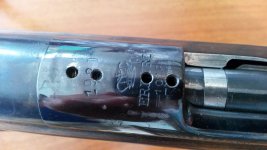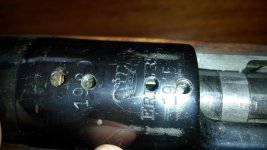It should say "Kar.98" on the siderail, though the German script can be confusing to read sometimes. The "1920" is a property marking, just means it was government property during the 1920 round up, the link feldmütze posted will give the full explanation.
As for the Erfurt arsenal, you are correct, they did not make sporting arms until the war was over, and then only as an expedience to keep workers employed (
and not rioting, which did happen when they did close them or when inspected by the IAMCC - also the "hope" to retain some capacity for making arms immediately after the war.. Versailles would remove any illusions of this later... Germany 1919-1923 was a chaotic place, all due to the Entente savage "peace" and violation of the armistice terms, - they more than anyone created Hitler and WWII), this rifle was once a Kar.98a, basically a small ring Modell98 carbine. Later it was sporterized for hunting or sporting, which they are excellent for, as they make very light and handy rifles when the stocks are cutdown.
As for the commercial sporters Erfurt did make after the war, they are elusive, they are largely scrubbed 98a receivers built up with modified 98a components, often they have simple designs on the receiver, usually carry the Imperial fireproof of Erfurt, - often with commercial proofing also, the siderail will have the Kar.98 removed and replaced with either Gwf.E (Gewehrfabrik Erfurt) or Rw.E (not sure what the Rw stands for, as they are for export, perhaps Rifleworks Erfurt?). Most will have "GERMANY" stamped into them, as most were probably sold for export. Danzig modells are far more common, and better manufactured, but these are not of much interest to military rifle collectors, - and your rifle is not one of these. Danzig's are more common because they lasted longer, as Danzig was removed from Germany and the arsenals fate not quickly decided upon, they made them longer as export was possible as Danzig was a League mandate. They even did small arms work for others, South America, Mexico and Poland, - Erfurt fate was never in question, it was later turned to mostly commercial pursuits, broken up into sections, the largest part became part of Deutsche Werke, a government held corporation. They would make some small arms, pistols and air rifles, probably covertly small arms. It is no coincidence that ERMA was important in the early rearmament programs.. like any aggrieved victim of aggression, a wrongly convicted inmate in prison, for a non-crime or wrongly convicted, they will be the most difficult to control, - and Germany felt this way after WWI and especially Versailles, and cheated on the terms of the treaty at every opportunity, rightfully so imo. Unfortunately things like resentment and fear lead to Hitlers.
View attachment 113280 I bought a custom hunting rifle 2nd hand that was built on an old Mauser action. It is an M98 (stamped on the side) with ERFURT 1915 and then 1920 stamped again with the serial number 57. I was told it was a small ring Mauser that was produced for sporting use, although what I understand from my reading is that the ERFURT factory was a state factory that made military rifles.
I would really like to know more about this action, which is now 100 years old. Does anybody know more about the additional 1920 stamp and the serial number 57 batch?
View attachment 113279Any info would be greatly appreciated.
 I bought a custom hunting rifle 2nd hand that was built on an old Mauser action. It is an M98 (stamped on the side) with ERFURT 1915 and then 1920 stamped again with the serial number 57. I was told it was a small ring Mauser that was produced for sporting use, although what I understand from my reading is that the ERFURT factory was a state factory that made military rifles.
I bought a custom hunting rifle 2nd hand that was built on an old Mauser action. It is an M98 (stamped on the side) with ERFURT 1915 and then 1920 stamped again with the serial number 57. I was told it was a small ring Mauser that was produced for sporting use, although what I understand from my reading is that the ERFURT factory was a state factory that made military rifles. Any info would be greatly appreciated.
Any info would be greatly appreciated.